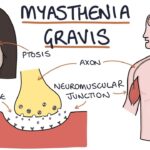Myalgia, commonly known as muscle pain, is a widespread condition affecting individuals of all ages. It can be acute or chronic and may result from various causes, including physical overuse, infections, autoimmune disorders, and neurological conditions. Understanding the underlying cause is crucial for effective management and treatment.

What Is Myalgia?
Myalgia refers to muscle pain that can affect a localized area or be widespread across multiple muscle groups. It can range from mild discomfort to severe, debilitating pain, often accompanied by stiffness, weakness, or fatigue. The condition may be temporary or persist due to underlying health issues.
Types of Myalgia
Myalgia is categorized based on its cause and severity:
- Localized Myalgia: Affects a specific muscle or muscle group, often due to injury or strain.
- Generalized Myalgia: Widespread muscle pain, common in systemic conditions like fibromyalgia.
- Acute Myalgia: Sudden onset, usually due to infections or trauma.
- Chronic Myalgia: Persistent pain lasting longer than three months, often associated with autoimmune diseases or neurological conditions.
Common Causes of Myalgia
1. Muscle Overuse and Injury
- Exercise-Induced Soreness: Delayed onset muscle soreness (DOMS) occurs after intense physical activity.
- Strains and Sprains: Overstretching or tearing of muscles and ligaments.
- Repetitive Motion Injuries: Occupational or sports-related strain leading to chronic pain.
2. Infections and Systemic Diseases
- Viral and Bacterial Infections: Influenza, COVID-19, Lyme disease, and other infections often cause muscle aches.
- Autoimmune Disorders: Conditions like lupus, rheumatoid arthritis, and polymyositis lead to chronic inflammation and muscle pain.
3. Neurological and Metabolic Conditions
- Fibromyalgia: A chronic condition characterized by widespread muscle pain, fatigue, and sleep disturbances.
- Multiple Sclerosis (MS): Neurological damage causing muscle weakness and discomfort.
- Hypothyroidism: Underactive thyroid leading to muscle stiffness and cramping.
4. Medications and Toxins
- Statins and Other Drugs: Cholesterol-lowering medications can induce muscle pain as a side effect.
- Toxic Exposure: Heavy metals, pesticides, and certain chemicals can cause muscle-related toxicity.
5. Psychological and Lifestyle Factors
- Stress and Anxiety: Chronic stress can lead to muscle tension and pain.
- Poor Posture: Sitting or standing improperly for extended periods can cause musculoskeletal discomfort.
- Dehydration and Nutritional Deficiencies: Lack of electrolytes and essential nutrients can trigger muscle cramps and pain.
Symptoms of Myalgia
Myalgia symptoms vary depending on the underlying cause but commonly include:
- Muscle tenderness and soreness
- Stiffness and reduced range of motion
- Fatigue and muscle weakness
- Cramping or spasms
- Pain that worsens with movement or pressure
- Joint pain associated with inflammatory conditions
Diagnosing Myalgia
To determine the cause of myalgia, healthcare providers may use the following diagnostic methods:
- Medical History and Physical Examination: Evaluating symptoms, lifestyle factors, and medical conditions.
- Blood Tests: Checking for inflammation, autoimmune markers, and infections.
- Imaging Studies (MRI, CT Scan, X-ray): Identifying injuries, nerve compression, or degenerative conditions.
- Electromyography (EMG): Assessing nerve and muscle function in neurological disorders.
Treatment and Management of Myalgia
1. Medications for Myalgia
- Pain Relievers: Over-the-counter NSAIDs (ibuprofen, aspirin) help reduce inflammation and pain.
- Muscle Relaxants: Prescribed for severe muscle spasms.
- Antidepressants and Anticonvulsants: Used in chronic pain conditions like fibromyalgia.
2. Physical Therapy and Rehabilitation
- Stretching and Strengthening Exercises: Improve muscle flexibility and strength.
- Massage Therapy: Enhances circulation and relieves muscle tension.
- Heat and Cold Therapy: Reduces inflammation and soothes sore muscles.
3. Lifestyle and Home Remedies
- Regular Exercise: Low-impact activities like swimming and yoga promote muscle health.
- Adequate Hydration: Prevents muscle cramps and dehydration-related pain.
- Balanced Diet: Nutrient-rich foods support muscle function and recovery.
- Stress Management: Meditation and relaxation techniques help reduce muscle tension.
4. Alternative Therapies
- Acupuncture: Helps relieve chronic pain by stimulating pressure points.
- Chiropractic Care: Addresses spinal alignment issues contributing to muscular discomfort.
- Transcutaneous Electrical Nerve Stimulation (TENS): Blocks pain signals to provide relief.
5. Surgical Interventions
Surgery is rarely needed but may be considered for cases involving:
- Severe muscle damage
- Compressed nerves requiring decompression surgery
- Chronic conditions unresponsive to conservative treatments
Preventing Myalgia
- Maintain proper posture to avoid muscle strain.
- Engage in regular physical activity to prevent stiffness and weakness.
- Stay hydrated and maintain a balanced diet to support muscle health.
- Avoid overexertion and allow adequate rest between workouts.
- Manage stress through relaxation techniques to prevent tension-related pain.
Myalgia is a common condition with various causes, ranging from minor strains to chronic diseases. Understanding its symptoms and seeking appropriate treatment can help manage pain effectively. By adopting preventive measures and maintaining a healthy lifestyle, individuals can reduce the risk of persistent muscle discomfort and improve overall well-being.

